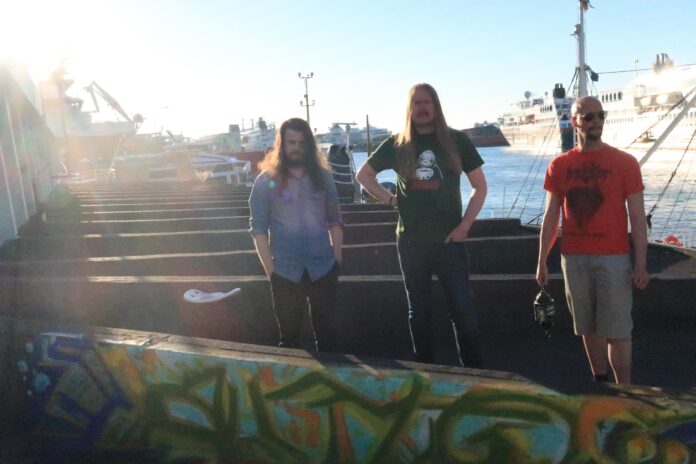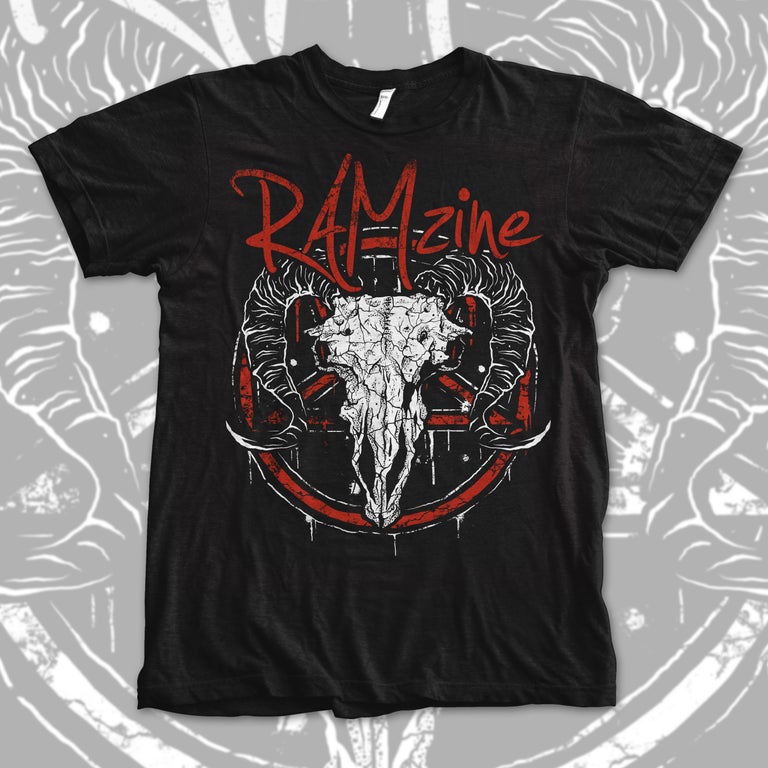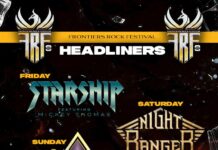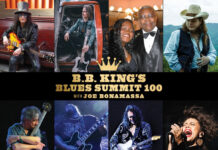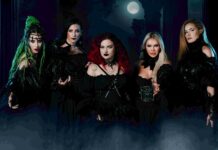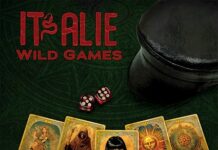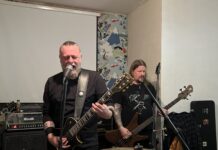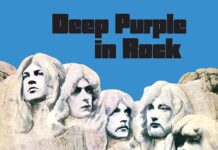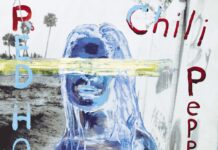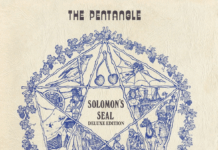In late May this year, the Norwegian outfit known as Strange Horizon released their sophomore album, namely the magnificent slab of doom-laden, stoner rock-influenced heavy metal entitled Skur 14, which is out via Apollon Records. Given that said piece of work immediately turned into a personal favorite of this scribe, the only thing that made sense was to delve more into this wicked creation and the people behind it, which is why RAMzine caught up with guitarist/vocalist Stig Kviljo in early June for a talk about all things Strange Horizon.
Greetings, Stig. How are we feeling today? For those readers of RAMzine who are unfamiliar with the glorious outfit that is Strange Horizon, could you provide us with an introduction to the band and a rundown of its history and releases?
Stig Kviljo (S): Busy times. I work as a teacher, so there’s a lot going in with exams and stuff like that. I barely have the time to release an album actually, ha-ha.
Strange Horizon was initially kind of a project that me and Andy, who now plays drums, had for many years. I wrote riffs and songs, and Andy was supposed to sing at the time. We were making an EP with some help from friends handling drums and bass, but due to technical and practical difficulties, it was never completed. I played in other bands between 2013 and 2017, but in 2016 I decided that I wanted to revive the Strange Horizon (SH) project with myself on guitar and vocals and try to recruit a rhythm section to form a band. I met Camilla that same year and she was interested in learning drums and joining a band. We had our first rehearsals in 2017 and started rehearsing regularly in 2018. That summer we played a gig with artwork man Lars Kvernberg (Gravy Jones) on bass and shortly afterwards we recorded the first demo. Christer helped us record that demo and it turned out that he wanted to join the band on bass when Lars moved to Oslo. In 2019 we rehearsed the first album and played a couple of gigs. Five songs of the album (‘Fake Templar’, ‘The Final Vision’, ‘Chains of Society’, ‘They Never Knew’ and ‘Divine Fear’) were recorded in late January 2020 and then the whole project was on hold from March until August that year. We finished the record in October 2020 with some add-ons done in early 2021. Camilla left the band following the recording session in October 2020, as she didn’t have the capacity to be in two bands in combination with her studies. She worked things out so that Eirik Arntsen (Kryptograf) could replace her. Early on we figured out that it was going to be temporary since Eirik is in several other bands and would eventually be very busy once live music started to be a thing again. We wrote the Skur 14 album in late 2020 and early 2021 and then recorded it during the summer of 2021. During that same time, I started to jam with Andy behind the kit and as he grew into the role, we realized that if we just had Christer playing bass this could work as a band. So, the band has now been me, Andy and Christer since around summer 2021, but both records released so far were recorded before he joined.
In 2022 we finally released the first album and played a few gigs in Norway with songs from the album and some new ones that we wrote with Andy during his first year in the band.
Musically and stylistically speaking, Strange Horizon exists somewhere between heavy metal, doom metal, and stoner rock, but there are quite a few proto-metal influences present too. Would I be completely off track if I said that certain riffs sound inspired by things ala Blue Cheer, Jimi Hendrix, and The Who? Tell me a bit about the trio’s shared influences and sources of inspiration – what exactly goes into the mix when you guys meet up in rehearsals and start jamming stuff?
S: If you’re talking guitar riffs then that’s a huge compliment ha-ha. We have all grown up with parents who were into rock during the 60s and 70s. My father is a huge Hendrix fan for example, but also introduced me to Black Sabbath, Deep Purple, Uriah Heep and many other classic acts when I became interested in music. Andy’s father is a huge fan of Genesis and Deep Purple, and Christer’s parents had both Judas Priest and Motörhead in their LP collection when he was a kid. In addition to that, there was a huge boom of obscure proto-hard rock becoming available thanks to reissues and the internet in the 2000s; Pentagram’s recordings from the 70s and the albums by Dust, Sir Lord Baltimore, Bang and bands like that. I doubt a lot of people in Norway knew those bands in the 70s, but that stuff became very popular among rock fans here around 2010 and had a huge effect on us as well.
So, we are all fans of 70s rock and it’s cool that you can hear that. The main inspiration for me when starting the SH project was Count Raven from Sweden. They and several other doom bands from the Hellhound label in the 90s inspired me personally, like Saint Vitus, The Obsessed, Iron Man and Revelation. Then you have the COTD stuff from the 2000s like Reverend Bizarre (from whose song we are named after), The Gates of Slumber, Orodruin, Minotauri and later on Lord Vicar. On the more fun side of things, you have Cathedral and The Lamp of Thoth from the UK. Paul Chain’s Alkahest album was a big influence on the style as well.
Me and Andy share a love for epic doom like Candlemass and Solitude Aeturnus while me and Christer have more in common when it comes to black metal and atmospheric music. The word “stoner” seems to be a negative word in the trad doom communities nowadays, but we definitely love classic stuff such as Kyuss, Electric Wizard, Sleep, Acid King and Goatsnake. And Sloth! The Sloth album beats pretty much anything that gets released these days.
I am not sure what Camilla was inspired by directly, but she is a huge fan of 80s heavy metal and brought some of that into songs like ‘Tower of Stone’ and ‘Chains of Society’. As you can probably tell from listening to Kryptograf, Eirik is a fan of Bill Ward and John Bonham, but he has many other influences as well. He told me that his drumming in ‘Candles’ was inspired by Dave Grohl.
Did I mention Black Sabbath? Yeah, we like them. It’s probably the one band that is mutually loved by all members, past and present. Lars Kvernberg (who handled bass duties on the Sonos Aestas MMXVII demo) has the biggest collection of Sabbath LPs I have seen – it’s insane.
There is really no limit when it comes to influences, and it’s not like we sit in a circle and listen to true doom bands and decide which bands to pay homage to. Since we all listen to that stuff, the influences and references come about naturally, but when we describe our own music, we often name-drop a lot of non-doom things such as “that bass line was a bit like Budgie” or “that lick had some Chuck Berry to it”. It’s all rock ’n roll!
I am curious as how you were introduced to the wonderful world of hard and heavy music. Do you recall one or two specific records that got you hooked and immediately sucked you in? What was your first heavy metal love affair, so to say?
S: The first angry song I loved as a kid was ‘Self Esteem’ by The Offspring. I just remember the semi-shouting vocals and the palm muted version of the riff in the verses and thinking it was awesome. Americana by said band was the first rock album I owned, but the real gateway to me becoming a music fan was borrowing Dimmu Borgir’s Enthrone Darkness Triumphant on a school trip in 2002. A few months later I bought Satyricon’s Volcano when it was just released. I still feel a ton of nostalgia listening to 90s Dimmu, but let’s just say the Satyricon album has aged a little better – still love that one. And I still listen to The Offspring as well sometimes.
As for doom and Sabbath worship, I was introduced to the Paranoid album sometime in 2002 by my father, after I’d heard those Dimmu Borgir and Satyricon records. So, Sabbath has “always” been there, but it really took off for me in 2005-2006 due to a bunch of different Sabbath-style records I heard, really. Sahg’s debut, Lamented Souls’ The Origins of Misery, Down’s NOLA and Black Debbath’s Den Femte Statsmakt were some of those records.
Christer adds that for him it was Judas Priest’s Defenders of the Faith and Motörhead’s Iron Fist from his parents’ collection. The first records he bought for his own money were Satyricon’s Nemesis Divina and Rancid’s Out Come the Wolves. A local punk rocker also showed him lots of British punk when he was a kid, like The Exploited, Sex Pistols, The Damned etc. Discovering Electric Wizard and Sleep got him hooked on doom in the mid-00s.
Andy was sucked into heaviness through Imaginations From The Other Side by Blind Guardian, which he downloaded and copied to a CD-R in the heydays of file sharing. The first heavy album he bought was Manowar’s Warriors of the World on the day of its release. For him, doom started with Candlemass and My Dying Bride, which he heard on the legendary radio show Ambolt in the early 2000s.
Going back to Strange Horizon, how did you go about composing and recording both Beyond the Strange Horizon and Skur 14 and did the one process differ radically from the other, i.e. did you approach Skur 14 differently to the debut LP? And how did the inclusion of Kryptograf’s Eirik Arntsen on drums influence the proceedings of the new album?
S: The majority of the material for the debut album was composed by me in the early 2010s, with ‘Turning the Corner’ and ‘Death in Ice Valley’ being more recent compositions. When I was writing alone, I’d often sit and play guitar in the morning and then take a shower and hum the stuff I had just played. That way I’d often get ideas on how to continue the song or various melodies that could fit with it.
When Camilla and I started playing she’d learn the songs based on demos with programmed drums that I had made, and some stuff we’d just figure out together. Lars and Christer wrote their own bass lines for the songs I had already composed. ‘Death in Ice Valley’ was a group effort, which I’ll get back to. We were originally going to release a 7” vinyl and then an EP as our first outings after the demo, but suddenly we realized that the seven tracks we had along with an atmospheric track would make a fine album, so we scrapped the EP ideas and booked time with Bjørn Ognøy (Solstorm, Yuma Sun) to record the album. We chose Bjørn because Camilla had worked with him on the EP by her other band Mordbrann and felt comfortable recording with him. It turned out great and we’ll work with him on future releases as well. The album was recorded in two sessions with the five “oldest” tracks being recorded first, and then we were supposed to just polish the other tracks for a few weeks before finishing the album, but then of course the first lockdown happened, so it took eight months until we could finish it.
Skur 14 was a different process, but also similar in some ways. It was not initially planned as an album. Eirik was with us and since there was no point in rehearsing a live set during Covid times, we decided to make a couple of new songs. Initially, it was just ‘Candles’ and ‘Tusser og Troll’, but the latter kept growing and we added a couple more songs, so it became a short album instead. The album was recorded in the very rehearsal room in Skur 14, Bergen (brilliantly portrayed on the cover by Simen Langeland) by Odd from Kryptograf. He had made some pre-productions of songs for The Eldorado Spell by just recording in the rehearsal room and they sounded really great. He wanted more experience, so he said yes to record our new songs.
On both records, drums were tracked live first with each member hearing direct input of bass and guitar on headphones. And then we added the other instruments and vocals later, and then some ambience and percussion at the end. With Bjørn on the debut we recorded in a proper studio while Odd’s setup was more DIY, but it’s really impressive how Skur 14 sounds. On the latter, Odd even kept some of the live DI stuff that me and Christer played since it sounded better live than when we attempted to re-do it. If you listen to the ending part of ‘Tusser og Troll’, the guitars, bass and drums are all live.
Are either you and/or the group as a whole spontaneous with respect to crafting songs and do the majority of them come about through extensive jamming, or do each of you bring ideas and riffs to rehearsals and then present them to each other?
S: This has changed quite a bit, especially after Christer came into the band. During the years when it was just a project, I wrote the songs myself and a couple of songs were also made into demos with programmed drums, like I mentioned before. When me and Camilla started, we rehearsed the songs I had that were the most complete ones, so we used the recordings and demos I had as templates for how the songs were going to turn out. In the past I always played in bands where each song was written in its entirety by one person who then taught it to the others, so that’s just how I was used to doing it.
The first group writing I ever took part in was ‘Death in Ice Valley’ from the first LP. Christer brought in the main riff, the ‘South of Heaven’-like melody that follows it and the chorus part. The rest of the song came about when me and him were throwing ideas back and forth during rehearsals that Camilla had to sit out, and then when she came back, we started to figure out drums for the song. That’s how Christer was used to do it, but to me it was a new method.
Skur 14 was a bit similar in some ways. The songs on side A (the first three tracks) were composed mainly by me in terms of riffs and melodies, while ‘Tusser og Troll’ was an idea Christer had that we worked together to complete, much like ‘Death in Ice Valley’. I did not make demos for the songs this time though, and most of the songs were written during 2020, whereas most tracks on the debut are quite old. So, on Skur 14 the material was fresher, and everyone had a bit more input in terms of the arrangements. Eirik had to sit out some rehearsals while Kryptograf were doing a stream gig and recording The Eldorado Spell. During those weeks, me and Christer used a drum machine to jam each part of ‘Tusser og Troll’, so a lot of the details on guitar, bass and vocals were figured out while jamming to the drum machine, and then we put everything together and figured out dynamics when Eirik was back.
Nowadays every member is present at pretty much every rehearsal, so we write more as a team now. We have written three original tracks since Andy joined. Each of these started with a riff from me or Christer and then we figured out the rest of the song together. It’s working really well. Sometimes we select a part and just jam it in order to get ideas for variations to play. The downside of this method is that I have a huge backlog of ideas from the project days that will most likely never see the light of day, because we keep coming up with new stuff all the time and it’s more exciting to work on a fresh idea. But I also hope we can go back and revisit some old ideas of mine or Christer’s every now and then. At least we won’t run out of material for a long time.
Did the pandemic ever halt the band’s progress in terms of exchanging ideas and collaborating on new material and so on?
S: The band was put on hold from March until August in 2020. We met a couple of times, but more as friends than as a band. The first recording session for the album was mixed during these months, but we didn’t play or exchange any ideas since the album was already written. We were working on a long instrumental track when the first lockdown came but cancelled it and decided to focus on completing ‘Tower of Stone’ and ‘Death in Ice Valley’ instead. We added ‘Turning the Corner’ instead of the cancelled song, which turned out to be a good decision.
I also worked on some solo projects alone in 2020, one of which materialized into Secret Rites with a demo on Bandcamp. I have a complete remixed version of the demo, waiting to be mastered and released. I hope I can do that soon.
A good thing about the pandemic for us was that the lack of live activity gave Eirik and Odd time to work with us in 2021. Of course, it sucked for Kryptograf that they couldn’t tour the debut album as planned, but I honestly doubt that Skur 14 would have been made as it is if it wasn’t for the restrictions that lasted into 2021. We’ll never know though.
As to the lyrics, could you briefly let us in on exactly what themes and ideas they relate to? What are ‘Death in Ice Valley’, ‘Fake Templar’, and ‘Candles’ about, for instance?
S: Some of the lyrics can and will mean different things to different people and I am not always comfortable with spelling out what I had in mind when I wrote it. I can say ‘Candles’ is intended as an anthem for creative souls, but I guess it’s possible to read many different things from it.
Does the local history of Bergen play a part in your lyrical narratives?
S: Yes. ‘Death in Ice Valley,’ which you asked about, is inspired by the criminal case known as “Isdalskvinnen” here in Norway. Christer had such sinister-sounding music, but I am not very enlightened when it comes to typical themes for such songs, like Lovecraft, occultism, or obscure horror movies, so I felt I had to go in a different direction with the lyric. Initially, I was looking for local myths or legends when I remembered a friend of mine had told me about this very mysterious case from the Cold War where an unidentified woman was found dead and burned in the woods outside Bergen. The lyric turned out a bit strange. It is intentionally confusing as each part refers to different theories about what happened to her, so it raises questions more than it gives any answers really, because at the end of the day no one knows, and it looks like we’ll never know. The title is borrowed from a podcast about the topic, and it just seemed like a perfect title for a metal song, so check that out if you are interested in the real story.
Another “Bergen” track with a less sinister theme is ‘The Road’ off the new album, which is inspired by Fjellveien – a road that runs along the side of mount Fløyen. I’ve been walking there a lot, both to reflect on things and seek inspiration, and the lyric is inspired by that. The “road of life” lyrical motif appears in other tracks as well.
What does 2023 hold for you apart from the release and promotion of Skur 14? A domestic tour or perhaps a few festival appearances throughout the summer? Or more recording sessions?
S: 2023 has been strange and a bit hard band-wise. First Andy broke his leg and then Christer was on long-term sick leave. We kept rehearsing most of the time, but often with just two members. Another thing that happened was that we recorded two new tracks and two cover songs last year, but they were all lost in a hard disc crash with no backup. That was out of our control, unfortunately. We are currently preparing for recording these tracks over again, as well as a brand new one that we wrote this year amidst all the chaos. Some of this will appear on a split with another band, and some of it will be on album number three. After recording those we will write the rest of the third album and then at some point record that as well.
We hope that people will check out and enjoy Skur 14 and that they will be a little patient with us while we recover and sort things out. We will be on stage again in the winter!
Thanks once again for your time, Stig. Much appreciated. Best of luck with your musical endeavours.
S: Thank you for your questions. Hail Peps Persson, Prima Vera and Paradise Lost!
https://strangehorizon.bandcamp.com/

